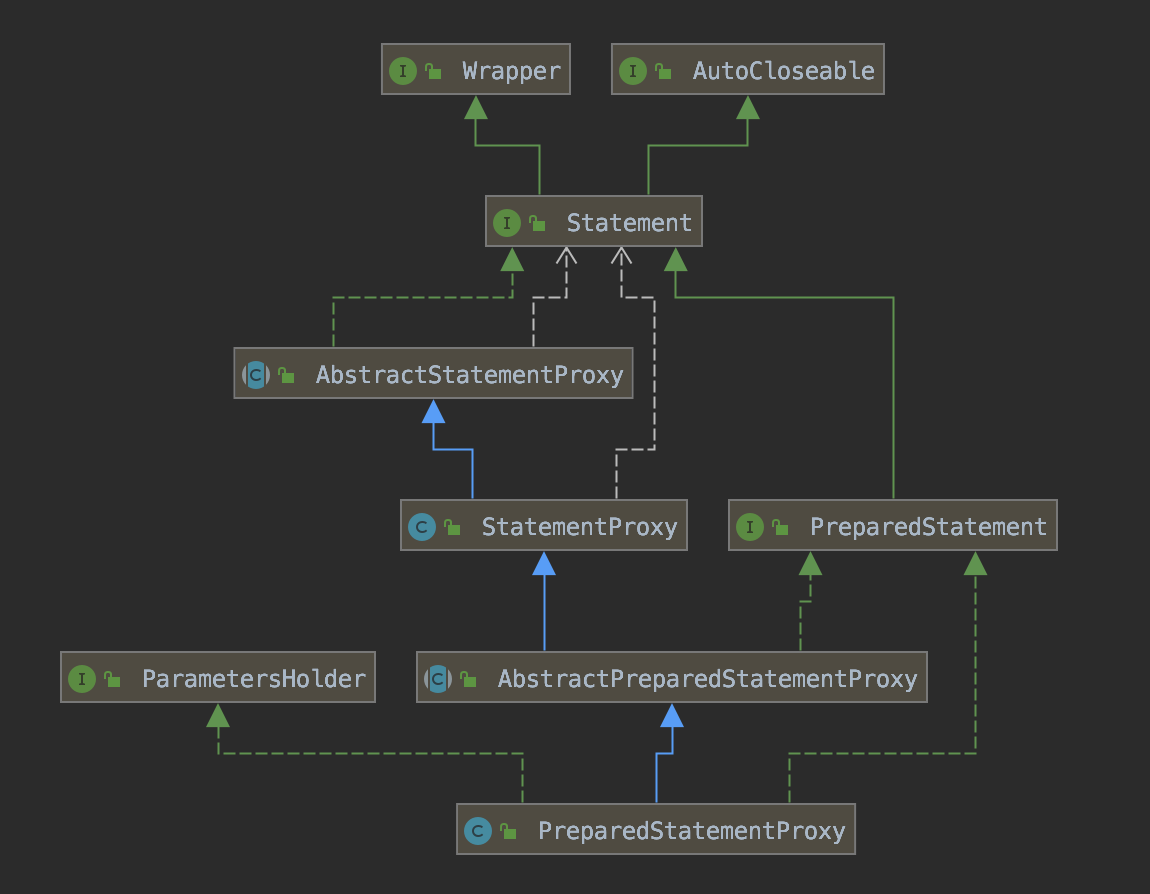所有文章
https://www.cnblogs.com/lay2017/p/12485081.html
正文
前两篇文章中 ,我们分别看到了DataSourceProxy被注册为Resource,ConnectionProxy注册分支事务到全局事务当中。
本文继续数据源代理的StatementProxy的内容
我们知道,Statement是由Connection生成的。那么StatementProxy将由ConnectionProxy生成
StatementProxy的uml类图
我们先看看类图

StatementProxy间接实现了Statement,所以也表示一个sql语句的执行对象。向下到最底,又被PreparedStatementProxy扩展。既然StatementProxy作为Statement的代理对象而存在,那么它组合了哪些原始的对象呢?
我们打开AbstractStatementProxy
public abstract class AbstractStatementProxy<T extends Statement> implements Statement { /** * ConnectionProxy对象 */ protected AbstractConnectionProxy connectionProxy; /** * 原始Statement对象 */ protected T targetStatement; /** * 原始的待执行sql */ protected String targetSQL; public AbstractStatementProxy(AbstractConnectionProxy connectionProxy, T targetStatement, String targetSQL) throws SQLException { this.connectionProxy = connectionProxy; this.targetStatement = targetStatement; this.targetSQL = targetSQL; } }
可以看到,除了被代理的Statement对象之外,在构造过程中还把ConnectionProxy和sql给包含进来了。
execute方法
Statement最核心的方法就是执行方法,我们以execute为例,看看该StatementProxy在代理Statement的时候做了哪些事
@Override public boolean execute(String sql) throws SQLException { this.targetSQL = sql; return ExecuteTemplate.execute(this, new StatementCallback<Boolean, T>() { @Override public Boolean execute(T statement, Object... args) throws SQLException { // 回调,执行原始的Statement的execute方法 return statement.execute((String) args[0]); } }, sql); }
可见,ExecuteTemplate的execute方法包含了核心的代理逻辑。跟进ExecuteTemplate.execute()
public static <T, S extends Statement> T execute(StatementProxy<S> statementProxy, StatementCallback<T, S> statementCallback, Object... args) throws SQLException { return execute(null, statementProxy, statementCallback, args); }
继续跟进execute方法,execute方法会解析当前待执行的sql语句,并判断sql语句的类型是insert、update、delete...通过类型来选择对应的Executor,然后执行。
public static <T, S extends Statement> T execute(SQLRecognizer sqlRecognizer, StatementProxy<S> statementProxy, StatementCallback<T, S> statementCallback, Object... args) throws SQLException { // 不存在全局事务,不存在全局锁 if (!RootContext.inGlobalTransaction() && !RootContext.requireGlobalLock()) { // 直接执行原始方法 return statementCallback.execute(statementProxy.getTargetStatement(), args); } if (sqlRecognizer == null) { // sql解析 sqlRecognizer = SQLVisitorFactory.get(statementProxy.getTargetSQL(), statementProxy.getConnectionProxy().getDbType()); } Executor<T> executor = null; if (sqlRecognizer == null) { executor = new PlainExecutor<T, S>(statementProxy, statementCallback); } else { // 根据解析出来的类型选择Executor switch (sqlRecognizer.getSQLType()) { case INSERT: executor = new InsertExecutor<T, S>(statementProxy, statementCallback, sqlRecognizer); break; case UPDATE: executor = new UpdateExecutor<T, S>(statementProxy, statementCallback, sqlRecognizer); break; case DELETE: executor = new DeleteExecutor<T, S>(statementProxy, statementCallback, sqlRecognizer); break; case SELECT_FOR_UPDATE: executor = new SelectForUpdateExecutor<T, S>(statementProxy, statementCallback, sqlRecognizer); break; default: executor = new PlainExecutor<T, S>(statementProxy, statementCallback); break; } } T rs = null; try { // executor执行 rs = executor.execute(args); } catch (Throwable ex) { if (!(ex instanceof SQLException)) { ex = new SQLException(ex); } throw (SQLException)ex; } return rs; }
跟进BaseTransactionalExecutor的execute方法
public Object execute(Object... args) throws Throwable { // 如果在全局事务当中 if (RootContext.inGlobalTransaction()) { String xid = RootContext.getXID(); // 将ConnectionProxy绑定XID statementProxy.getConnectionProxy().bind(xid); } // 设置全局锁标识 if (RootContext.requireGlobalLock()) { statementProxy.getConnectionProxy().setGlobalLockRequire(true); } else { statementProxy.getConnectionProxy().setGlobalLockRequire(false); } return doExecute(args); }
注意到,XID是在这里被绑定到ConnectionProxy的。
上一篇文章我们说过,ConnectionProxy在commit的时候会根据是否存在XID来判断要不要注册事务分支之类的操作。所以,这里的bind方法将决定是否当前Connection处于全局事务当中。
接下来继续跟进AbstractDMLBaseExecutor的doExecute方法
@Override public T doExecute(Object... args) throws Throwable { AbstractConnectionProxy connectionProxy = statementProxy.getConnectionProxy(); // 判断自动提交标志位 if (connectionProxy.getAutoCommit()) { return executeAutoCommitTrue(args); } else { return executeAutoCommitFalse(args); } }
doExecute方法根据autoCommit标志位来选择执行方法,执行方法中包含了StatementProxy的生成undoLog的核心点。
我们选择相对比较清晰的executeAutoCommitFalse这个方法看看
protected T executeAutoCommitFalse(Object[] args) throws Exception { // 前置生成数据记录 TableRecords beforeImage = beforeImage(); // 执行sql语句 T result = statementCallback.execute(statementProxy.getTargetStatement(), args); // 生成后置数据记录 TableRecords afterImage = afterImage(beforeImage); // 生成undoLog prepareUndoLog(beforeImage, afterImage); return result; }
beforeImage和afterImage由子类实现,分别生成sql执行前后的数据记录。
prepareUndoLog将根据前后的数据记录生成一份SQLUndoLog,顾名思义undo_log就是用于在分支事务rollback的时候做补偿操作的。
flushUndoLog持久化到数据库
undoLog到这里还只是存在于内存当中,当ConnectionProxy的执行完register注册分支事务以后,在本地事务提交之前就会将undoLog给flush到数据库中。
我们跟进AbstractUndoLogManager的flushUndoLogs方法
@Override public void flushUndoLogs(ConnectionProxy cp) throws SQLException { ConnectionContext connectionContext = cp.getContext(); String xid = connectionContext.getXid(); long branchID = connectionContext.getBranchId(); // 构建一个分支事务undoLog对象 BranchUndoLog branchUndoLog = new BranchUndoLog(); branchUndoLog.setXid(xid); branchUndoLog.setBranchId(branchID); // 获取undoLog内存对象 branchUndoLog.setSqlUndoLogs(connectionContext.getUndoItems()); UndoLogParser parser = UndoLogParserFactory.getInstance(); // 解析器解析后生成字节码 byte[] undoLogContent = parser.encode(branchUndoLog); // insert到数据库表当中 insertUndoLogWithNormal(xid, branchID, buildContext(parser.getName()), undoLogContent, cp.getTargetConnection()); }
核心逻辑就是获取上文中的SqlUndoLog集合,然后持久化到数据库undo_log表当中,给分支事务的rollback预留。
总结
到这里,本文就结束了。可以看到,StatementProxy主要就是在sql执行后生成SqlUndoLog。而在ConnectionProxy的commit方法里,将分支事务register以后会把SqlUndoLog给flush到数据库当中。
undoLog的作用就是用于rollback操作补偿的,所以这里就是预留的一个undo的操作。
我们再回顾一下数据源代理的三个核心对象
1)DataSourceProxy注册了Resource
2)ConnectionProxy注册分支事务,持久化UndoLog,并先提交本地事务
3)StatementProxy执行sql,生成undoLog
我们可以暂时简单地把数据源代理这一过程理解为,主要是为rollback预留undo操作,如果执行顺利异步删除undoLog即可。